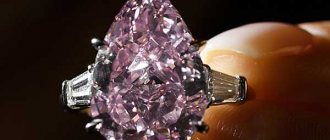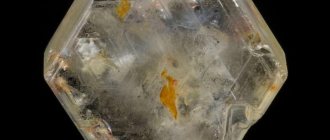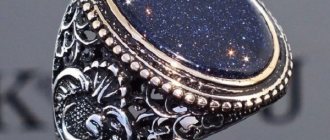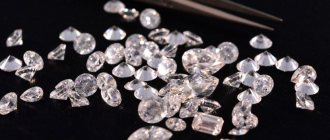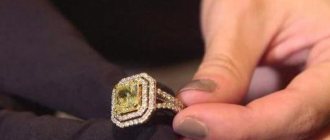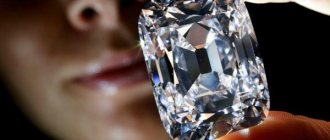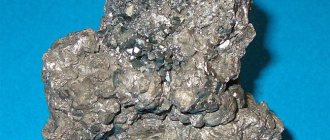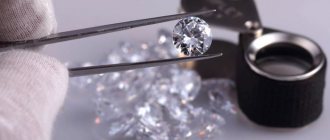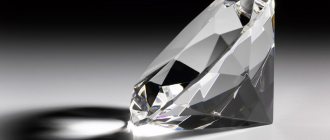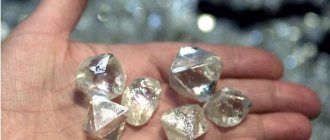What is a diamond?
Ordinary people often confuse diamonds and diamonds, believing that they are two different precious stones. In fact, a diamond is a very well-cut diamond. And diamonds have many uses:
- they are used in industry, for example, to create extremely hard saws and drills;
- they are processed and turned into valuable jewelry;
- They are used to make special coatings, for example, for frying pans, so that food does not burn.
The chemical composition of diamonds and rough diamonds is identical, so the only difference is in the scope of application and the presence of a cut. There are a lot of industrial diamonds in the world, but there are few suitable for turning into diamonds, and this gives them special value.
How to distinguish
Cut shape
A specialist can easily distinguish the cutting technique of officially released zircons from the processing of diamonds. Main characteristics of cubic zirconia:
- the number of facets is more or less than 57 (when cutting diamonds, the number of facets is strictly equal to this number);
- The surfaces of artificial gems are round.
The listed properties visually highlight zircons, but they apply only to officially released crystals - fake stones are processed using the same technique as real diamonds (i.e. there is no difference in the shape of the products). Therefore, the classic cut cannot be 100% accurate about the authenticity of the stone.
A moment of history
Diamond mining is a very difficult and very profitable business. Everyone knows about the gold rush, but few know that there was also a diamond rush. At the end of the 19th century, rich diamond deposits were discovered in Africa. The news quickly spread across the Old and New Worlds, and prospectors of all stripes flocked to South Africa. Subsequently, the city of Kimberley was founded there.
Miners of the past believed that diamonds formed in river beds. The truth turned out to be different: in fact, 90% of diamonds are mined in kimberlite pipes - natural wells of volcanic origin. These formations were named after that African settlement. They look like this:
Diamonds are found on all continents except Antarctica. In addition to Africa, large deposits of the valuable mineral are located in Russia, Australia and Canada.
The value of diamonds is partly due to the complexity of their processing. It is believed that diamond is an incredibly hard material that can cut glass and metal. This is true. However, the other side of the coin is increased fragility. The mineral is almost impossible to scratch, but relatively easy to break. Because of this, they did not dare to process it for a very long time, and only in the 15th century did the Indians offer an effective technology for making diamonds.
The word “diamond” itself translated from French means “shining, bright, brilliant.” This perfectly reflects the main thing in the appearance of the stone and the very thing for which beauty connoisseurs love it.
Documents for purchasing a diamond
When purchasing diamonds, the buyer has the right to request a special product passport, a GIA certificate. This document states:
- crystal weight;
- cleanliness parameters;
- defects;
- origin of the stone.
Note! The seller is obliged to provide a passport/certificate for the gem free of charge. You can request paperwork for your diamond at any point of purchase (such as a large Sunlight chain or a small retail store). Any excuses and refusal to show documents about the manufacturing plant may indicate a forgery.
What is cubic zirconia?
This is an artificial and relatively cheap material, very similar to a gemstone in appearance, but differing in properties. Its production is a rather difficult and painstaking process, but it cannot be compared in complexity to high-quality cutting of a diamond.
The price per gram of good cubic zirconia reaches $5.
The artificial mineral received its name from the Physical Institute of the Lebedev Academy of Sciences (FIAN). It was there that it was synthesized by a team of Soviet scientists in the 1970s. It is noteworthy that the goal of the project was to obtain a substance with special optical properties suitable for creating laser equipment.
Artificial stone has several names. Chemists know it as zirconium dioxide. In the West, it is more often called zirconite, jewellite or daimonstone.
The invention of Soviet scientists caused a real sensation among both fashionistas and jewelers. Compared to a diamond, this stone was worth pennies. In 1990, 50,000,000 carats of cubic zirconia were produced, and this is an astronomical amount. Every year the pace of production is accelerating, and more and more synthetic gems are entering the markets.
Basic properties of stones
A diamond is a processed natural diamond. Such crystals are the hardest rock in the world and are distinguished by a special processing option (strictly 57 faces). The cost of one gem depends on the carat value and can vary from 50,000 to 1,000,000 rubles (how much a particular option costs depends not only on the number of carats/diameter, but also on the shade of the crystal).
Interesting! The largest diamond in the world weighed more than 600 grams and had impressive dimensions (approximately 3000 carats - 0.2 grams equals 1 dimensional unit according to the table). Several pieces of jewelry were made based on it.
Jewelry with diamonds is characterized by a high cost, which encourages the production of fakes (glass or other stones are not easy to identify when cut accordingly).
Cubic zirconias are produced synthetically in laboratory conditions, due to this their cost is quite low. Such stones are used to create jewelry and complement precious jewelry. Synthetic cubic zirconia differs from diamond in hardness and is characterized by a large number of facets. Regarding the refractive index of light, such crystals are quite close in quality and external properties to natural minerals.
Be sure to see: Where and how emeralds are mined
Cubic zirconia can be created to be as similar as possible to diamond, ruby, sapphire and other natural crystals. Outside Russia, such stones are known as zirconite or dzhevalite. In addition to its jewelry value, this crystal is actively used in the creation of optical equipment.
Key differences between diamonds and cubic zirconias
We will also dwell on the intricacies of testing at home, but for now take a look at the table. It will make it clear what the basic differences between the stones are.
| Criterion | Diamond | cubic zirconia |
| weight | easy | 2-3 times heavier with the same volume |
| cut shape | sharp, clear edges | differs in slightly rounded edges |
| conductivity of heat | high (does not fog up) | low (fogs up) |
| the power of radiance | glare of high intensity due to excellent refractive power (with the correct cut and large stone size) | the intensity of the radiance is barely noticeably lower for large crystals, and higher for small ones |
| grease wettability | good, the shape of the fat trace is unchanged | bad, the fat trail spreads like a blot |
As you can see, there are differences, but they do not allow you to determine by eye what kind of stone is in front of you. It is unlikely to be possible to weigh them, because minerals are often inserted into rings and earrings.
How to determine in a ring?
You can check a fake by eye in a ring or in earrings by looking at the markings. Natural stone is always framed with precious metals, which are marked with special stamps.
It is recommended to look for the 14K, 750, 900 signs on gold products, and PT and Plat on platinum products. Another way is to look closely at the stone.
To achieve shine and play of light, the diamond is placed in an open frame; this method of mounting allows you to see the lower edges of the diamond.
A sign of a fake is the mirror coating of the lower edges.
Basic characteristics of a diamond
The price of a gemstone is determined by its quality. It consists of four main criteria:
- Carat.
- Features of the cut.
- Color.
- Purity of the stone.
Let's take a closer look at each of them.
Carat
To make it easier to measure precious stones and pearls, a non-systemic unit of mass was introduced - the carat. It is equal to 200 milligrams.
The heavier the stone, the more expensive it is.
The largest diamond found weighed an incredible 3,106 carats. The price of one carat of a good quality diamond is approximately 750,000 rubles. Remember what we said about the price of a gram of cubic zirconia...
Origin and appearance of the fake
Cubic zirconia is not a precious stone, but an artificial one, created in the sixties of the last century at the USSR Academy of Sciences, at the Physical Institute. Hence the name - it is an abbreviation for “place of birth”. By the way, they don’t call it that abroad. Other names in use are jevalit, zirconite (although it has nothing to do with real zirconium).
Cubic zirconia also acts as an imitation of other stones - sapphires, topazes, rubies. To do this, it is tinted.
Green color comes from chromium; yellow, red or orange - cerium; pink – erbium. Cubic zirconias are often used in jewelry, but sometimes they replace diamonds in products made of precious metals.
Although an artificial diamond is just a cheap fake, it often looks more attractive than the original. The crystal has perfect purity, and the play of light on its edges is much brighter than that of a diamond.
Comparison of a real diamond and a fake at home
Not everyone is ready to shell out money to test a gem in a laboratory. However, there are many ways to verify the authenticity of a stone that you can use on your own.
Do you dream of diamonds?
Yes, I have
By certificate availability
You should only purchase expensive jewelry from trusted jewelry stores. There you will be given a certificate for the product confirming that the stone is of natural origin. Certification is carried out by various authoritative institutions, for example, the Gemological Center of Moscow State University or the most authoritative Gemological Institute of America. When purchasing from an unknown retail outlet or even secondhand, you run the risk of receiving a cubic zirconia product at a diamond price.
By price
Jewelry with a real diamond cannot be cheap. You can compare prices for different rings on the Internet and get an idea of what you can expect.
If a store offers to buy a product for 3000-8000 rubles, this is, at BEST, cubic zirconia. Most likely, scammers are offering a plastic or glass “stone”.
According to the seller's reaction
If you buy a stone, for example, in a Tiffani salon, it will be 100% genuine. But if you decide to purchase jewelry from a little-known showroom at a suspiciously attractive price, ask the seller for permission to scratch the stone. If a store sells real gems, the seller will agree, because a hard diamond can only be scratched with the same diamond. If an inspection is prohibited, this is a reason to think about it.
By cleanliness
Artificially created cubic zirconia has absolute purity, while a real diamond always has flaws. Take a magnifying glass and examine the stone. If you manage to find a small dot, cavity or darkening, you have the original.
Checking the stone for flaws
By cut
The cutting of a diamond is carried out at the highest level, because it determines whether the jewel will play with light. If you make a mistake at this stage, the diamond will turn into a cloudy and unattractive crystal. All edges must be smooth and sharp, symmetry must be maintained.
A cubic zirconia crystal usually has slightly rounded edges; they can double.
To notice this, you will need a very good magnifying glass (at least with tenfold magnification), or even better, a microscope.
Diamond cut pattern
With fat
A good method to independently determine the authenticity of a stone. Drip vegetable oil onto the surface of the mineral. The fat will flow smoothly over the surface of the diamond, and on the cubic zirconia it will separate into drops and blots. In addition, a greased genuine stone will stick to the glass, but an artificial one will not.
On sale you can find special felt-tip pens suitable for carrying out fat testing.
By hardness
This method is glorified in detective stories and TV series. Diamond can cut glass. Cubic zirconia can only scratch it. Use this method with caution so as not to damage the jewelry. And under no circumstances try to hit the stone with a hammer; neither the fake nor the original will withstand such a test.
You can run a nail file over the gem. If it leaves scratches, it means you got a fake. You can use sandpaper, just make sure there are no diamond chips on it.
To the light
If you are going to buy a large crystal, look through it at the sunlight. A genuine diamond should not allow rays to pass through; through it you will only see a blurry dot. Cubic zirconia is more transparent, you can easily read a book through it.
Using heat
The method is based on the different thermal conductivities of stones. If you breathe on a real diamond, nothing will happen. But cubic zirconia will fog up in such a situation. You can also simply take the stone in your hand and hold it for a few seconds. The real mineral will remain cool.
With acid
A very risky method is based on the fact that cubic zirconia will become stained under the influence of hydrochloric acid, but a genuine diamond will not change. We do not recommend using this method to recognize the authenticity of jewelry, as it can ruin everything.
Using ultraviolet
If you have an ultraviolet lamp, place a ring or earring with a stone under it. A real diamond will glow dimly blue, while a fake diamond will glow phosphorescent.
By density and weight
The method is suitable if the stone is not inserted into the jewelry. You will need electronic scales, a calculator, a glass of water and a thread. Check procedure:
- weigh the stone;
- place a glass of water on the scale instead of a stone;
- reset the electronic scales;
- attach the stone to a string and completely immerse it in water so that it does not touch the walls;
- divide the weight of the stone by the result that appears on the scale now.
If it turns out to be 6.25 or more, you are dealing with cubic zirconia. The density of real diamond is 3.51 g/cm³.
A fake can be identified simply by weight. Natural diamond will be heavier.
By frame
If you have a ring, earring or brooch, pay attention to what material they are made of. The setting of a real diamond is always made of precious metals such as gold or platinum. In this case, gold is taken at least 585 samples, and platinum - 900. This data must be on the product.
In cheap products, the frame is made of low-grade gold, silver, and in advanced cases - of steel.
Experiment using fat
Such an experiment can be carried out on large stones without a frame - more than 3-5 carats (with small specimens it is quite difficult to notice the result). To identify a fake, you will need any fat - butter or vegetable oil. A simple test for adhesiveness can be done at home or in a laboratory: a natural diamond will instantly stick to glass, but an artificial cubic zirconia will not.
Such differences are due to the non-wetting property of crystals of synthetic origin. For this reason, any fat on the surface of the zircons will collect in one drop. On diamonds, the oil will spread evenly, making the surface of the crystal as oily as possible and slightly sticky to the glass.
This stone is shrouded in legends of death that attract people more than the beauty of “Black Orlov” itself.
Title... Published by Arideam Diamonds. Saturday, September 29, 2012
Professional authentication methods
When combining different home testing methods, the result is most likely to be correct. However, there are cases when the fake is made so well that it is impossible to do without the help of special equipment and expert knowledge. The hardest thing is to distinguish between diamond and moissanite, but cubic zirconia sometimes confronts a person with a non-trivial task. In general terms, we will convey how professionals work in such cases.
By reflection
The specialist takes a special device and analyzes the crystal. Diamond, glass, cubic zirconia or other material will have different reflection coefficients. This cannot be determined by eye, and the necessary device costs a lot.
By conductivity of electricity
Synthetic stones are semiconductors, meaning they conduct electricity. Experts have equipment that allows them to evaluate the degree of conductivity and make a conclusion about whether the stone is real.
Using a microscope
This magnifying device will allow you to see what is hidden from the most powerful magnifying glasses. The smallest defects, cutting features, sharpness of edges - these signs will indicate authenticity or fakeness.
Through an electron microscope you can see the grain structure of the crystal. In synthetic stones, at this magnification, clusters of microscopic-sized single crystals are visible. They seem to have grown together. In natural materials, single crystals are faceted.
Another option is to combine a polariscope with a microscope, and then in polarized light you will see “copies” of the seed crystal. Any single crystal, no matter how it grows, will repeat the shape of the seed. And the seed itself will be visible as a darkened zone in the middle of the former uncut crystal.
Methods that should not be used
A large number of fake jewelry provokes the use of a variety of methods to identify artificial stone. The following are unsuccessful check options:
- Open fire test. A natural diamond burns under significant heat, so the owner can not only verify its authenticity, but also say goodbye to the stone.
- Friction with sandpaper. Various abrasives for construction purposes are made from artificial diamonds, which may not be inferior in strength to natural options (borazon, elbor, etc.). Rubbing with sandpaper can not only damage the metal frame, but also leave scratches on the surface of the stone.
- Determining authenticity using defects (cracks, cloudiness, foreign inclusions). This method will not cause damage to the product, but the detection efficiency will be low. High-quality diamonds and their fakes do not have any defects that are visible to the eye.
Note! You should not use chemical reagents to test jewelry or stones; if you have any doubts about the originality, it is better to contact an experienced jeweler.
Hardness and thermal conductivity
The advantage of diamond over cubic zirconia is its high strength. It is 15% higher than the hardness of artificial stone. If you rub a diamond with sandpaper, not a trace will remain on it, but a synthetic stone will be fairly scratched. Of course, if it turns out that cubic zirconia is inserted into the jewelry, it will be doubly offensive, since the inserts will suffer. A more acceptable way to check the naturalness of a stone is thermal conductivity.
To do this, you need to lower your fist with a stone clamped in it into the water - you will feel as if your hand is soapy. This effect is due to properties inherent only to natural stones - they absorb gases in water. Cubic zirconia does not have this ability.
Oil and water test
The following experiment can be carried out if the stone is not part of the decoration. It needs to be placed in ordinary water and examined from the side. Cubic zirconia will be clearly visible, and the natural mineral will practically disappear. This is where the expression “pure diamond” comes from.
Whether the jewelry is with a gold “accompaniment” or on its own, ordinary vegetable oil or fat will help establish authenticity. If a diamond is smeared with oil and applied to the glass with its largest edge, it will stick. Cubic zirconia will disappear. It is also dense, so the animal fat on it breaks down into several drops. A single drop remains on the diamond.
For the last test you will need a magnifying glass with twenty times magnification. The stone must be viewed in natural light. A diamond does not double its rays, but if you have an artificial analogue in front of you, they will double. Finding the difference this way is not easy if you don’t have practice, but you can evaluate rings, necklaces, and any jewelry without separating the stone.
Production technology
Swarovski cubic zirconias are artificial stones that combine oxygen and zirconium in their composition. They are made in laboratories in two ways:
- In a chamber with a pressure of up to 60 kilobars and a temperature of 1400–1600 °C, artificial minerals up to 1 carat are grown over 5 days.
- Chemical deposition. The most common method is microwave plasma deposition using a mixture of methane and hydrogen gases.
